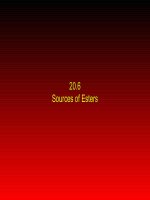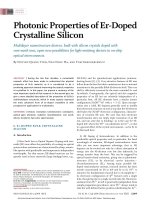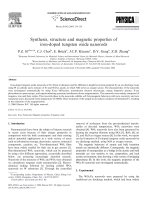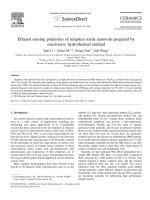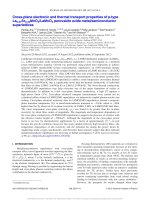Magnetotransport properties of strontium doped lanthanum manganite nanoconstriction array
Bạn đang xem bản rút gọn của tài liệu. Xem và tải ngay bản đầy đủ của tài liệu tại đây (5.62 MB, 159 trang )
MAGNETOTRANSPORT PROPERTIES OF STRONTIUM
DOPED LANTHANUM MANGANITE
NANOCONSTRICTION ARRAY
LIU HUAJUN
NATIONAL UNIVERSITY OF SINGAPORE
2007
MAGNETOTRANSPORT PROPERTIES OF STRONTIUM
DOPED LANTHANUM MANGANITE NANOCONSTRICTION
ARRAY
LIU HUAJUN
(B. Sc., Jilin University
M. Sc., Jilin University)
A THESIS SUBMITTED
FOR THE DEGREE OF DOCTOR OF PHILOSOPHY
DEPARTMENT OF PHYSICS
NATIONAL UNIVERSITY OF SINGAPORE
2007
Acknowledgements
I would like to express my deepest gratitude to my supervisor Prof. Ong Chong Kim.
Working on a PhD project is more than just learning the scientific facts and obtaining
the scientific findings and conclusions presented in the thesis. A PhD training should
help in building up scientific and analytical thinking, learning to study everything
with a critical eye and developing a strong attitude. Prof. Ong directed me to realize
that and to develop these skills.
I would also like to express my great appreciation to my co-supervisor Dr. S. N.
Piramanayagam in Data Storage Institute (DSI). His support and guidance are
indispensable for me to complete my PhD project. To my project collaborator
Asst./Prof. Sow Chorng Haur, thank you for your guidance, sharing your knowledge
and experience at the beginning of this project and for your encouragement at hard
times. Your kindly help without asking for anything in return makes me owe you a lot.
Thanks to Dr. Tan Chin Yaw for the suggestion in experimental work, the help in
troubleshooting the experimental facilities and being a good friend all these years. To
Dr. Goh Wei Chuan for the discussions and suggestion on my project and most
importantly, being my best friend in Singapore. To Dr. Yang Tao from Beijing
University for his practical and even emotional help in the first year of my PhD work.
To Mr. Tan and other members in workshop of Physics department of NUS, many of
whom I even don’t know their names, thank you for your help in setting up some
experimental facilities, which make it possible for my project to progress forward.
i
Thanks to my fellow colleagues in CSMM and Department of Physics, NUS,
including Dr. Chen Linfeng, Dr. Rao Xuesong, Dr. Wang Shijie, Dr. Yan Lei, Dr.
Kong Lingbin, Mr. Wang Peng, Ms Liu Yan, Mr. Lin Guoqing, Ms Wu Yuping and
all those have shared their time helping me and discussing with me in this project.
Their help are greatly appreciated.
Thanks to Prof. Yang Shaoguang from Nanjing University and Prof. Chen Xianhui
form University of Science and Technology of China for the valuable discussion and
good advices.
Thanks to my flatmates Mr. Gu Jie, Mr. Peng Guowen, Mr. Zhan Jiaming, Mr. Gao
Fei, Mr. Chai Anwei for the great time we spent together, the mutual support and
encouragement and friendship.
I would also like to acknowledge the financial support from the National University of
Singapore for providing scholarship during this course of study.
Last but not least, I would like to thank my family for supporting me and helping me
both spiritually and financially throughout the long years of pursuing my study abroad.
None of this would be possible without their love and concern.
ii
Table of Contents
Page
Acknowledgements i
Table of Contents iii
Abstract vi
List of Publications ix
List of Tables x
List of Figures xi
1. Introduction 1
1.1 Magnetic field sensor 2
1.1.1 History of the development of read head in hard disk drive 2
1.1.2 Low-field magnetoresistance of magnetic nanoconstriction 6
1.1.3 Method for fabrication of nanoconstriction 10
1.2 Colossal magnetoresistive manganite 17
1.2.1 Basic properties of manganites 18
1.2.2 Double exchange interaction 22
1.2.3 Phase separation scenario 24
1.2.4 Current status of the study of manganites 25
1.3 Objectives and significance of the study 27
1.4 References 29
2. Apparatus for sample preparation and characterization 36
2.1 Apparatus for samples preparation 36
2.1.1 Pulsed laser deposition 36
2.1.2 Ion beam etching and reactive ion etching 39
2.1.3 Photolithography 41
2.2 Apparatus for Crystal and microstructure characterizations 43
2.2.1 X-ray diffractions 43
iii
2.2.2 Morphology characterizations 45
2.3 Magnetic property characterization 48
2.4 Transport properties measurement system 49
2.5 References 53
3. Fabrication of LSMO nanoconstriction array via nano-
sphere lithography
55
3.1 Overview of the nanopattern fabrication 55
3.2 Nanosphere lithography 58
3.3 Three fabrication process based on NSL technique 62
3.3.1 LSMO thin film deposition 62
3.3.2 Deposition of monolayer of hexagonally closed-packed
microspheres
65
3.3.3 Fabrication process I 70
3.3.4 Fabrication process II 72
3.3.5 Fabrication process III 76
3.4 Summary 79
3.5 References 82
4. Magnetotransport properties of LSMO nanoconstriction
arrays with non-intrinsic states
80
4.1 Nanoconstriction array (A) – weakened-ferromagnetically coupled 80
4.1.1 Experimental procedures 80
4.1.2 Results and discussions 81
4.2 Nanoconstriction array (B) – stress induced phase separation 89
4.3 Nanoconstriction array (C) – oxygen deficiency induced phase
separation 94
4.3.1 Experimental procedures 95
4.3.2 Results 96
4.3.3 Discussions 98
4.4 Comparison of the three non-intrinsic LSMO nanoconstriction
Arrays
103
4.5 Summary 104
4.6 References 106
iv
5 Magnetotransport properties of intrinsically
ferromagnetic LSMO nanoconstriction arrays
114
5.1 Magnetotransport properties 114
5.2 Domain structure of the LSMO nanoconstriction array 117
5.2.1 OOMMF (Object Oriented Micromagnetic Framework) 118
5.2.2 Simulation results of LSMO nanoconstriction array 120
5.3 Discussions 125
5.3.1 Domain wall resistance 125
5.3.2 The influence of the geometry of nanoconstriction 126
5.3.3 Comparison with the non-intrinsic LSMO nanoconstriction
arrays
132
5.4 Summary 132
5.5 References 134
6 Conclusions and future work 136
6.1 Conclusions 136
6.2 Future work 138
6.3 References 140
v
Summary
Magnetic read head, one of the most important components in the hard disk
drive, has experienced evolutionary and revolutionary changes to meet the require-
ment of the ever increasing areal density of hard disk drives in the past decades. In
the exploration of new designs and materials for the read head, the magnetic
nanoconstriction attracted much attention recently due to its ultra small size and
surprisingly large low-field magnetoresistance (MR) at room temperatures. Up to now,
most of the investigations on the magnetic nanoconstriction focused on the
transitional magnetic metals such as Fe, Co and Ni and to date no consensus has been
reached on the origin of the large MR observed in this system.
In this work, we first aimed to develop a simple but effective approach to
fabricate nanoconstrictions of complex oxides. Half metallic La
0.67
Sr
0.33
MnO
3
(LSMO)
was chosen as a studying object. LSMO nanoconstriction arrays with different
physical states at the place of nanoconstriction have been fabricated to study the
influence of the physical state of the nanoconstriction on its magnetotransport
behavior, hoping to obtain some helpful information on the origin of the large MR in
magnetic nanoconstrictions.
Three fabrication processes were developed by integrating nanosphere
lithography (NSL), pulsed laser deposition (PLD), and reactive ion etching (RIE)
techniques for the fabrication of LSMO nanoconstriction arrays. The first process
simply employed a monolayer of close-packed SiO
2
microspheres as mask for ion
beam etching of LSMO thin film. The second process used a monolayer of SiO
2
microspheres, the dimension of which can be tuned through RIE process, as mask for
LSMO thin film deposition using PLD technique. The third process was the
vi
combination of the first and the second ones. It firstly employed the second process to
fabricate a nanopatterned SrTiO
3
(STO) thin film on top of a continuous LSMO thin
film and then this nanopatterned STO thin film was used as a hard mask for ion beam
etching of the underlying LSMO thin film. All of the three processes showed
capability of fabricating LSMO nanoconstriction with lateral size smaller than 100 nm.
Moreover, the LSMO nanoconstrictions fabricated through these different fabrication
processes had different physical state, providing an opportunity to investigate their
roles in the magnetotransport behaviors in the nanoconstricted systems.
In the ferromagnetic island/nanoconstriction of weakened ferromagnetic
coupling/ferromagnetic island system fabricated through process I, a large spin-
polarized current effect was observed. The spin-polarized current would strengthen
local ferromagnetic coupling when passing through the nanoconstricted region and
cause a large drop of resistance.
In the ferromagnetic island/phase separated nanoconstriction/ferromagnetic
island system, fabricated through process I and post-situ annealing, resistance steps
were observed at large bias current. The critical current value at which resistance
jump occurs varied with temperatures and the applied magnetic fields. A large low-
field magnetoresistive ratio of 52.2% was achieved at 78K with the magnetic field up
to 3000 Gauss when the biased current was set to 0.34 mA.
In the nanoconstricted phase separated system fabricated through process II, a
size dependence of the magnetotransport behavior was observed. Compared with
system with larger lateral size, the system with smaller lateral size has a lower metal-
insulator transition temperature, a larger magnetoresistance at the same bias current,
and a larger electroresistance at the same external magnetic field. This size
dependence can be understood in the framework of phase separation by taking into
vii
account the size dependence of the fraction of insulating phase and the percolation
threshold for the metallic phase.
Compared with the novel transport behaviors in the nanoconstriction arrays in
the non-intrinsic states (weakened magnetic-coupling state and phase separated state),
the transport properties of the intrinsically ferromagnetic LSMO nanoconstriction
array, fabricated through process III, were more like those of a single crystal or an
epitaxial thin film: linear I-V characteristic and very small low field
magnetoresistance. The magnetic domain structure simulation showed that broad
domain walls, zigzag and vortex domain structures, rather than abrupt domain wall,
were energetically preferred at these intrinsically ferromagnetic LSMO
nanoconstriction arrays with lateral size down to 25 nm. This is the main reason why
no large low field magnetoresistance was observed.
These results suggest that the non-intrinsic states at the place of
nanoconstriction are crucial for the LSMO nanoconstriction of lateral size of sub-100
nm to obtain large nonlinear transport properties and low field magnetoresistance.
Although the results of this project cannot rule out of the domain wall resistance
contribution to the ultra large low field magnetoresistance in the atomic-sized
magnetic nanoconstriction, they do lend some support to the viewpoint that the ultra
large low field magnetoresistance in magnetic nanoconstriction is an extrinsic
properties due to defect state or magneto-mechanical effect, rather than an intrinsic
property due to the domain wall resistance.
viii
List of Publications
1. H. J. Liu, T. Yang, W. C. Goh, C. H. Sow, S. N. Piramanayagam, and C. K.
Ong, “Magnetotransport properties of nano-constriction array in La
0.67
Sr
0.33
MnO
3
film
”, Eur. Phys. J. B, 48, 37 (2005)
2.
H. J. Liu, C. K. Ong, “Resistance steps and large magnetoresistive effect in
La
0.67
Sr
0.33
MnO
3
nanoconstriction array” Appl. Phys. Lett., 87, 262507 (2005)
3. H. J. Liu, C. H. Sow, and C. K. Ong, “Fabrication of quasi-one dimensional oxide
nanoconstriction array via nanosphere lithography: A simple approach to
nanopatterns of multicomponent oxides
”, J. Appl. Phys., 100, 014306 (2006)
4. H. J. Liu, C. K. Ong, “Size dependence of the nonlinear transport properties in
arrays of nanoconstrictions in phase separated La
0.67
Sr
0.33
MnO
3-δ
”, Phys. Rev. B, 74,
052409 (2006)
5. Y. Liu, L. F. Chen, C. Y. Tan, H. J. Liu, and C. K. Ong, “Broadband complex
permeability characterization of magnetic thin films using shorted microstrip
transmission line perturbation
”, Rev. Sci. Instrum., 76, 063911 (2005)
6. Y. G. Ma, H. J. Liu, and C. K. Ong, “Electron transport properties in CoAlO
composite antidot arrays
”, Europhysics. Lett., 76, 1144 (2006)
ix
List of Tables
pg
Table 1.1 Summary of the experimental findings reported in magnetic
nanoconstrictions
13
Table 3.1 Summary of the three fabrication process based on NSL
technique
81
x
List of Figures
Pg
Figure 1.1 Illustration of the development of the read head technique.
[9]
3
Figure 1.2 Schematic representation of the GMR effect. (a): Change in
the resistance of the magnetic multilayer as a function of
applied magnetic field. (b): The magnetization
configurations (indicated by the arrows) of the trilayer at
various magnetic fields: the magnetizations are aligned
antiparallel at zero field; the magne-tizations are aligned
parallel when the external magnetic field H is larger than
the saturation field Hs. (c): The magnetization curve for the
trilayer.
5
Figure 1.3 Magnetoresistive measurement of a Ni-Ni nanocontact [2].
The variations of the conductance (upper diagram) and the
applied field (lower diagram) with time were recorded
synchronously.
7
Figure 1.4 Magnetoresistive measurement of an electrodeposited Ni-
Ni na-nocontact [3]. Five successive measurements were
performed.
8
Figure 1.5 Several most frequently used methods for the fabrication of
magnetic nanoconstriction. (a) Two wires ending with
rounded tips face each other and were push into a contact
[33]. (b) By screwing the driving rod to bend the flexible
substrate, the metallic wire is first elongated until break,
and then brought back into contact to form a nano-
constriction [31]. (c) The electrodeposited Ni nano-
constriction is deposited in the gap between two Ni wires
[29]. (d) nanoconstrictions are formed in the process of
electro-deposition through pinholes in an insulating film
[35]. (e) nanoconstriction fabricated by e-beam lithography
[48]. (f) preparation of nanoconstriction using a hole in an
insulating membrane while monitoring the resistance
during deposition [40].
16
Figure 1.6 The ideal cubic perovskite structure, ABO
3
. A is a large
cation, similar in size to O
2-
, B is a small cation such as
Mn
3+
or Mn
4+
, octahedrally-coordinated by oxygen.
18
Figure 1.7 Phase diagram of temperature vs tolerance factor for the
system RE
0.7
M
0.3
MnO
3
, where RE is a trivalent rare earth
ion and M is a divalent alkali earth ion. [60]
19
xi
Figure 1.8 (a) Temperature dependence of resistivity for La
1-x
Sr
x
MnO
3
crystals. (b) Electronic phase diagram of La
1-x
Sr
x
MnO
3
.
Open circles and filled triangles ar the Nėel (T
N
) and Curie
(T
C
) temperatures, respectively. The abbreviations mean
paramag-netic insulator (PI), paramagnetic metal (PM),
spin-canted insulator (CNI), ferromagnetic insulator (FI),
and ferro-magnetic metal (FM). [61]
20
Figure 1.9 (a) Temperature dependence of resistivity for
La
0.8
Sr
0.2
MnO
3
crystals under various magnetic fields. (b)
Correlation between the temperature dependence of
resistivity and magnetic moment for La
0.8
Sr
0.2
MnO
3
. [61]
20
Figure 1.10 Spin-resolved photoemission spectra from a T
C
=350 K thin
film sample of La
0.7
Sr
0.3
MnO
3
at (a) T = 40 K and (b) T =
380 K. [62] (c) Schematic energy diagrams of the doped
manganites at T<<Tc and at T>Tc. At T<<Tc, the carriers
are spin polarized. At T>Tc, the manganite is insulating and
non-ferromagnetic.
22
Figure 1.1 Schematic diagram of the double exchange mechanism.
The two states Mn
3+
- O
2-
- Mn
4+
and Mn
4+
- O
2-
- Mn
3+
are
degenerated if the manganese spins are parallel.
22
Figure 1.12 Illustration of the formation of a percolation path with the
decrease of temperature in phase separated manganites. [74]
24
Figure 2.1 A schematic drawing of the Pulsed Laser Deposition
system.
38
Figure 2.2 Schematic of ion beam etching system. 40
Figure 2.3 Typical process steps involved in lithographic processing. 42
Figure 2.4
Schematic of XRD θ-2θ scan.
44
Figure 2.5 Schematic diagram showing the main components of a
SEM.
45
Figure 2.6 Schematic drawing of an atomic force microscope
operating in tapping mode.
47
Figure 2.7 Schematic illustration of the experimental set-up for the
transport properties measurement.
52
Figure 3.1 Typical procedure of NSL process (left: side view, right:
top view). (i) atomically flat substrate; (ii) deposition of
monolay-er of nanospheres; (iii) thin film deposition
masked by the monolayer; (iv) triangular dot array after
removal of nanospheres.
59
xii
Figure 3.2 XRD pattern of an epitaxial La
0.67
Sr
0.33
MnO
3
thin film on
STO (001) substrate.
63
Figure 3.3 Magnetization hysteresis loop of LSMO film measured at
300 K with magnetic field along [100] direction (in plane).
Inset: Magnetization hysteresis loop of the LSMO film at
300 K in magnetic with magnetic field along [100] (in
plane) and [001] (out of plane) respectively.
64
Figure 3.4 Temperature dependence of resistance of LSMO thin film
at different magnetic field.
65
Figure 3.5 Self-assembly strategies to create ordered
microsphere array. (a) hand-drop-coating in which capillary
forces and evaporation induce spheres self-organization. (b)
lifting up a sphere array from an interface using the
substrate. (c) electrophoretic deposition of spheres. (d)
chemical or electrochemical deposition of sphere solution
with a pattern array. (e) physical template-guided self-
organization of sphere. (f) spin-coating in which shear and
capillary forces drive the sphere self-organization. [28]
66
Figure 3.6 (a) a drop of suspension spread on the substrate, forming a
convex surface. (b) a glass tube is used to produce a
concave surface by taking advantage of the wettability of
water with glass.
68
Figure 3.7 Monolayer of hexagonally close-packed microspheres. (a)
0.5 μm, (b) 0.7 μm, (c) 1.0 μm, (d) 1.5 μm, The scale bars
are 1.0 μm. (e) a large area of monolayer of microspheres.
The defects such as point defects, dislocations, and grain
boun-daries can be seen. The scale bar is 10 μm.
69
Figure 3.8 Fabrication process I, microsphere monolayer served as
mask for ion beam etching.
70
Figure 3.9 AFM image of nanoconstriction array on LSMO thin film
after ion beam etching for 60 minutes. The brighter regions
are the residual LSMO film. Nanoconstrictions of around
50 nm in width are fabricated in LSMO film.
71
Figure 3.10 Fabrication process II. Nanosphere monolayer served as
mask for the thin film deposition.
73
Figure 3.11 (a) SEM image of a monolayer of highly ordered SiO
2
micro-spheres. (b) The honeycomb-like pattern grown at 2
× 10
-1
mbar oxygen atmosphere in the process of PLD. (c)
The pattern of triangular nanoparticle array grown at 5 ×
10
-5
mbar oxygen atmosphere in the process of PLD. Inset:
75
xiii
SEM image with a larger magnification. The microsphere
monolayers used as mask for deposition in (b) and (c) were
not subjected to RIE process.
Figure 3.12 SEM images of the resultant nanoconstriction array grown
after the masking microspheres were subjected to (a) 5 min.
(b) 10 min. of RIE process.
76
Figure 3.13 Fabrication process III. Combination of process I and
process II. Nanosphere monolayer served as mask for STO
thin film deposition, which served as hard mask for further
ion beam etching process.
77
Figure 3.14 SEM image of the resultant LSMO nanoconstriction array
fabricated through process III. The STO layer is not
removed yet. The scale bar is 1.0 μm.
79
Figure 4.1 Schematics of the sample preparing process. (a) deposition
of a monolayer of SiO
2
microspheres onto the center of the
LSMO film (b) the top view of the film covered by photo-
resist except a strip at the center of the film and subjected to
ion beam (c) after the ion beam etching, the photoresist has
been cleared and the microspheres have been removed (d) a
microbridge is fabricated on the etched area for transport
measurement.
86
Figure 4.2 R-T curves of film with bias current of 1 μA after being
etched for 60 minutes. The two curves represent the
measure-ments carried out with and without applied field of
3000 Gauss respectively. Inset: curve of the original film
where T
P
is above 300 K with resistance much smaller than
the etched film by several orders of magnitude.
87
Figure 4.3 Temperature dependence of the resistance of
nanoconstriction array with bias current from 10 nA to 1
μA under zero-field. The pea resistance became smaller and
the TP shifted to a higher temperature when the bias current
increased.
88
Figure 4.4 characteristics of the nanoconstriction array under different
temperature without applied field. This nano-constriction
array has stronger nonlinear I-V characteristics at low
temperatures.
89
Figure 4.5 Current dependent of MR curves of the nanoconstriction
array at 80 K. The MR ratio increased with decreasing bias
current.
89
Figure 4.6 R-T curve of the nanoconstric-tion array after annealing at
750
o
C in the atmosphere of oxygen for one hour. The bias
91
xiv
current is 1.0 μA.
Figure 4.7 V-I characteristic measured at 78 K with a current swept
from +1.0 mA to -1.0 mA. A series of discontinuities were
observed. Within every continuous section, the transport is
still ohmic with a different slope. Inset: R-I curve with the
current decreasing from 1.0 to 0.2 mA. Four resistance
steps can be seen clearly.
95
Figure 4.8 R-I curves with the current increasing from 0.2 to 0.5 mA
and then sweeping back. A hysteric loop was observed.
96
Figure 4.9 R-I curves measured at different temperatures. With the
tempe-rature increasing, the critical current at which the
resistance jump occurs decrease and the resistance step is
less apparent.
96
Figure 4.10 R-I curves measured at 78 K under a different magnetic
field with the current increasing from below 0.3 mA to
above 0.5 mA and then sweeping back. Both I
up
th
and I
down
th
increase with the external field increasing (see inset).
It can be seen that an external field as low as 3000 Gauss
will lead to large drop of resistance when the current is 0.34
mA.
97
Figure 4.11 SEM image of the patterned microbridge for transport
measurement. Inset: schematics of the microbridge and Au
electrodes
100
Figure 4.12 The temperature dependence of resistance at different bias
currents of sample (a) and sample (b). Both samples exhibit
current dependent resistance in the whole measured
tempera-ture range. The whole temperature range was
divided into three regions. In the region I (T<Tp
a
), both
samples have percolative conduction path; in the region II
(Tp
a
<T<Tp
b
), percolation occurs in sample (b) and sample
(a) is still in insulating state; in the region III (T>Tp
b
),
neither sample has percolation path.
101
Figure 4.13 The temperature dependence of ER ratio of Sample (a) and
Sample (b) without external magnetic field. ER =
100%x[R(0.1μA)-R(100μA)]/R(100μA). Both samples
show a peak ER ratio near the metal-insulator transition
temperature Tp.
102
Figure 4.14 Schematics of sample (a) and sample (b) in the region II in
the random resistor network model.
105
Figure 4.15 The temperature dependence of MR ratio of Sample (a) and
Sample (b) at a bias current of 1 uA. MR = 100%x[R(0)-
107
xv
R(H)]/R(H). Both samples show a peak MR ratio near the
metal-insulator transition temperature Tp. The peak
magneto-resistance value of Sample (a) is apparently larger
that that of Sample (b). Inset: MR curves of the 90-nm
nanoconstriction array measured at 140 K with different
bias current. With the increase of bias current, the MR
ratios of the nanoconstrictions decrease.
Figure 5.1 The temperature dependences of resistance of LSMO
nanocon-striction array at 0.0 and 1.0 Tesla respectively.
The I-M transition temperature T
P
is apparently above 350
K.
115
Figure 5.2 The I-V characteristics of the LSMO nanoconstrictions at
80 K and 300 K respectively. Strictly ohmic behavior was
observed at these two temperatures.
116
Figure 5.3 The field dependences of resistance of the LSMO
nanoconstr-iction array at different temperatures. Inset: low
field magneto-resistance of the sample at 80 K measured
near the coercive field.
117
Figure 5.4 Illustration of the geometry of the simulated sample. The
black region represents the LSMO film and the white
region repress-ents STO substrate. D is the diameter of the
micro-sphere used in the fabrication process and d is the
size of the nanoconstrictions
120
Figure 5.5 Simulated domain structure of the LSMO nanoconstriction
array with D = 0.5 μm and d = 100 nm. The length of an
arrow represents the xy plane component of the
magnetization and the color of an arrow represents its z
component in Red-Black-Blue colormap. The color of pixel
represents the y component of the magnetization in Red-
Green-Blue-Red colormap. In addition to domain walls
formed at several nanoconstrictions, zigzag domain
structure and vortex domain structure are formed, as circled
in the figure.
123
Figure 5.6 Simulated domain structure of the LSMO nanoconstriction
array with D = 0.5 μm and d = 25 nm. The length of an
arrow represents the xy plane component of the
magnetization and the color of an arrow represents its z
component in Red-Black-Blue colormap. The color of pixel
represents the y component of the magnetization in Red-
Green-Blue-Red colormap. The magnetizations at the place
of nanoconstriction are aligned with the nanoconstriction
due to the large shape anisotropy.
124
Figure 5.7 Nanoconstrictions of different geometry. (a) arc shaped (b)
rectangular shaped (c) triangular shaped
127
xvi
Figure 5.8 Simulated domain structures of the arc shaped permalloy
nano-constrictions with different geometric parameters. The
length of an arrow represents the xy plane component of the
magnetization and the color of an arrow represents its z
component in Red-Black-Blue colormap. The color of pixel
represents the x component of the magnetization in Red-
Green-Blue-Red colormap.
129
Figure 5.9 Simulated domain structures of the rectangular shaped
permalloy nanoconstrictions with different geometric
parameters. The length of an arrow represents the xy plane
component of the magnetization and the color of an arrow
represents its z component in Red-Black-Blue colormap.
The color of pixel represents the x component of the
magneti-zation in Red-Green-Blue-Red colormap.
130
Figure 5.10 Simulated domain structures of the triangular shaped
permalloy nanoconstrictions with different geometric
parameters. The length of an arrow represents the xy plane
component of the magnetization and the color of an arrow
represents its z component in Red-Black-Blue colormap.
The color of pixel represents the x component of the
magnetization in Red-Green-Blue-Red colormap.
131
xvii
Chapter 1 Introduction
Chapter 1 Introduction
In the last decade, the areal density of hard disk drive has doubled every 18
months [1]. The revolutionary development of the read head, one of the key devices in a
hard disk drive, played an
indispensable role in enhancing the capacity of the hard disk
drive, especially in the 1990s when the giant magnetoresistive (GMR) head was
introduced [1]. With continuous shrinkage of the single bit size, read heads with smaller
size and larger magnetoresistance (MR) ratio are necessary for future applications.
In the exploration of the new designs and new materials for the read head,
magnetic nanoconstrictions attracted much attention recently [2-4]. The nanoscale size
and the surprisingly large low-field MR of the magnetic nanoconstriction make it
possible to read the signals from atomically small domains, which would theoretically
allow the manufacture of the hard disk drive of trillion of bits per square inch. Materials
with higher spin polarizations are believed to be crucial to achieve a high low-field MR
ratio in a magnetic nanoconstriction [5]. A group of magnetic oxides, including Fe
3
O
4
,
CrO
2
, and La
0.67
Sr
0.33
MnO
3
(LSMO), famous for their high spin polarization [6,7], are
believed to be strong candidates to fabricate nanoconstriction of higher MR ratios. A very
large low-field MR ratio at room temperature observed in Fe
3
O
4
nanoconstrictions
recently has confirmed the application potential of these materials [8].
Before we come to the concept of nanoconstriction, it is necessary to give a brief
review of the history of the development of the read head in hard disk drive to understand
how the concept of magnetic nanoconstriction was developed. Then the possible physics
about the magnetic nanoconstriction and the challenges in fabrication at the current stage
will also be reviewed, all of which will be covered in the section 1.1. The material used in
1
Chapter 1 Introduction
fabricating nanoconstriction is another crucial factor in obtaining higher MR ratio.
Manganites, used in this work, will be introduced in the section 1.2, including their
properties, several important theoretical models and the status of current investigations.
1.1 Magnetic read sensor
Magnetic read sensor is mostly used as read head in the hard disk now. It is one of
the most important components in the hard disk and the only one component that
experienced a revolutionary change in structural design and working principle. However,
fabricating a read sensor for the hard disk drive of Tbit/in
2
is still a challenge for the
current science and technology.
1.1.1 History of the development of read head in hard disk drive
The ever increasing demand for higher areal density in hard disk drive has driven
the read head to be smaller and more sensitive since the birth of the first hard disk. This
development of the read head is illustrated in figure 1.1.
As shown, the first generation of read head is the inductive read head, which
detects signals by measuring the voltage change across the coils induced by the flux
variation when the head passes by the recorded bit. Although the performance of the
inductive head has been improved continuously to meet the requirement of rapidly
increasing areal density, it is very difficult to further enhance its sensitivity and integrity
in terms of its structural design and working principle. At the beginning of 1990s, it was
replaced by magnetoresistive head [1].
2
Chapter 1 Introduction
Figure 1.1 Illustration of the development of the read head technique [9]
The concept of MR head was first proposed by Hunt in 1971 [10]. This kind of
head is widely called anisotropic magnetoresistive (AMR) head which took advantage of
AMR effect, i.e. the resistivity of some ferromagnetic materials is a function of the
orientation between current and the magnetization due to the spin-orbit interaction. The
amplitude of the AMR ratio usually varies from less than 1% to a few percent, depending
on the type of materials. The mostly common used AMR read sensor material is the
permalloy at a composition near 81% Ni and 19% Fe, of which the MR ratio is about 2-
4%, depending on the thickness of the thin film and deposition method [1].
3
Chapter 1 Introduction
Although the AMR read head shows much better performance in terms of
sensitivity and scalability than the thin film inductive head, it still could not keep up with
the pace of the rapid advance in areal density due to the difficulty in further structural
miniaturization because the MR ratio of the AMR head decreased rapidly when its
thickness is reduced to less than 10 nm [11]. This difficulty was overcome by the
introduction of a much larger MR effect called giant magnetoresistive (GMR) effect – a
spin dependent scattering effect. This GMR effect was first discovered in magnetic and
nonmagnetic metallic multilayer [12, 13], and later adopted in the design of spin-valve
read head [14]. The core concept of the GMR head is the artificial sandwich structure in
which two ferromagnetic metallic layers are separated by a nonmagnetic metallic spacer
layer. The change in the resistance of the trilayer arises when the applied field aligns the
magnetic moments of the two ferromagnetic layers which are antiparallel at the absence
of magnetic field, as illustrated schematically in Figure 1.2.
There are two different configurations of spin-valve GMR head depending on
whether the current flows in the plane of the stack of layers or perpendicular to them. The
former is called a current-in-plane (CIP) GMR head, and the latter a current-
perpendicular-to-plane (CPP) GMR head [15]. Now the CIP GMR head has been
commercialized and dominant in the market. The CPP GMR head is expected to play an
important role in future terabits recording systems.
When the non-magnetic metallic spacer layer in the sandwich structure of CPP
GMR head is replaced by a very thin non-magnetic insulating layer, we get a new
spintronic device which is called magnetic tunneling junction (MTJ) [16]. The electrical
conduction in MTJ is based on quantum-mechanical tunneling. The tunneling current
4
Chapter 1 Introduction
Figure 1.2 Schematic representation of the GMR effect. (a): Change in the resistance of
the magnetic multilayer as a function of applied magnetic field. (b): The magnetization
configurations (indicated by the arrows) of the trilayer at various magnetic fields: the
magnetizations are aligned antiparallel at zero field; the magnetizations are aligned
parallel when the external magnetic field H is larger than the saturation field Hs. (c): The
magnetization curve for the trilayer
5
Chapter 1 Introduction
through the barrier is larger when the magnetization in the two electrodes is parallel than
that when they are aligned antiparallel, resulting in a large so-called tunneling
magnetoresistive (TMR) effect, a spin dependent tunneling effect [17]. Although the
TMR effect has been known since the mid 1960s, only recently have significant room
temperature MR signals (beyond 100%) been obtained thanks to the use of MgO as
insulating barrier [18, 19], making it very attractive for applications in magnetic read
heads and magnetic random access memory [20].
Then, what will happen if the spacer layer of the magnetic sandwich structure of
GMR and MTJ head is replaced by only a domain wall? This structure is the prototype of
the magnetic nanoconstriction, also called magnetic nanocontact, which has become a hot
topic in this area recently [2-4, 21].
1.1.2 Huge low-field magnetoresistance of magnetic nanoconstriction
In the last several years, there has been an increasing interest in magnetic
nanostructures which show magnetoresistive phenomena. Beside the fundamental interest
in spin dependent transport in low-dimension systems, it was to a large extent motivated
by Garcia et al’s report of a 280% MR ratio at room temperature in a field of 20 Oe in Ni
nanoconstriction [2], as shown in figure 1.3. This was followed by reports of large MR
ratio in Fe [22] and Co [23] nanoconstrictions fabricated through the same technique. In
these experiments, the electron transport behavior is believe to be ballistic since the
conductance usually stabilizes near integer multiples of the conductance quantum
G
0
=2e
2
/ħ, which is an evidences for the very small size of these constrictions. The large
MR ratio observed in magnetic nanoconstrictions was therefore termed ballistic
6



